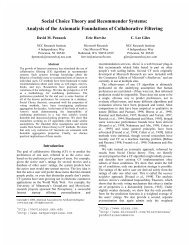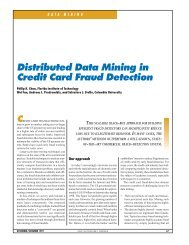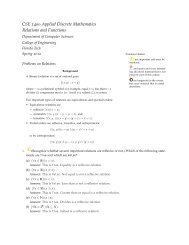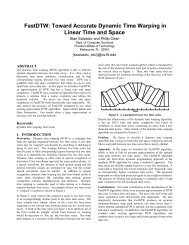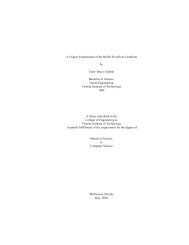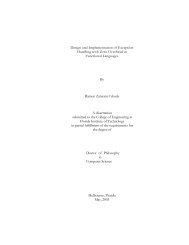A Virtual Machine Introspection Based Architecture for Intrusion ...
A Virtual Machine Introspection Based Architecture for Intrusion ...
A Virtual Machine Introspection Based Architecture for Intrusion ...
Create successful ePaper yourself
Turn your PDF publications into a flip-book with our unique Google optimized e-Paper software.
traps and interrupts that occur while a virtual machine isrunning transfer control to the VMM. Attempts by the virtualmachines to access privileged operations trap into theVMM; the VMM emulates privileged operations <strong>for</strong> theVM. In this architecture, the VMM can always control thevirtual machine regardless of what the software in the virtualmachine does.Memory is commonly virtualized by keeping a virtualMMU <strong>for</strong> each virtual machine that reflects the VM’sview of its address space. The VMM retains control ofthe real MMU, and maps each VM’s physical memory insuch a way that VMs do not share physical memory witheach other, or with the VMM. Through this technique theVMM is able to create the illusion that each VM has itsown address space that it fully controls. This also allowsthe VMM to isolate the VMs from one another and preventsthem from accessing the memory of the VMM.In addition to virtualizing the CPU and memory, theVMM intercepts all input/output requests from VMs tovirtual devices and maps them to the correct physical I/Odevice. For memory-mapped I/O, the VMM only allowsa virtual machine to see and access the particular I/O devicesit is permitted to use.3.3 VMM AssuranceOur argument <strong>for</strong> the security of a VMI IDS rests onthe assumption that a VMM is difficult <strong>for</strong> an attacker tocompromise. We base this assumption on the claim thata VMM is a simple-enough mechanism that we can reasonablyhope to implement it correctly. We have severalreasons <strong>for</strong> this claim. First, the interface to a VMM issignificantly simpler, more constrained and well specifiedthan that of a typically modern operating system. Whilethe VMM is responsible <strong>for</strong> virtualizing all of the architecture,many portions, such as virtualization of the CPU,require little participation on the part of the VMM, sincemost instructions are unprivileged. Second, the protectionmodel of a VMM is significantly simpler than that of amodern operating system. Everything inside the VMMis completely unprivileged with respect to the VMM, andthe VMM has only to provide isolation, with no concernsabout providing controlled sharing. Finally, although aVMM is an operating system, it is significantly simplerthan standard modern operating systems. VMM’s suchas Disco [5] and Denali [53], which have both virtualizedvery complex architectures, have been built in on the orderof 30K lines of code. This simplicity is attributable to thelack of a filesystem, network stack, and often, even a fullfledged virtual memory system. 1 Some will point out thatthe small size and simplicity of a VMM do to its lack of1 This also applies to hosted VMMs as components such as the networkstacks will not be utilized, and need not even be included in thehost OS.a filesystem and network stack is misleading, since thesefacilities must ultimately be available to per<strong>for</strong>m administrativefunctions such as logging and remote administration.However, this overlooks the fact that these activitiesare not part of the core VMM, but run in a completelydifferent protection domain, typically in an administrativeVM that is strongly isolated both from other VM’s andfrom the secure kernel of the VMM. While there is a riskthat this administrative VM(s) could be compromised, thecompartmentalization provided by a VMM does a greatdeal to limit the extent of a compromise.The small size and critical functionality of VMMs hasled to a significant investment in their testing, validation,etc. Notable projects that have made strong claims <strong>for</strong> thesecurity of VMMs include the Vax security monitor [21]and the NSA with their Nettop [29] system. Nettop alsorelies on VMware Workstation <strong>for</strong> its VMM. Ultimately,since VMware is a closed-source product, it is impossibleto verify this claim through open review.3.4 Leveraging the VMMOur VMI IDS leverages three properties of VMMs:Isolation Software running in a virtual machine cannotaccess or modify the software running in the VMMor in a separate VM. Isolation ensures that even ifan intruder has completely subverted the monitoredhost, he still cannot tamper with the IDS.Inspection The VMM has access to all the state of a virtualmachine: CPU state (e.g. registers), all memory,and all I/O device state such as the contents of storagedevices and register state of I/O controllers. Beingable to directly inspect the virtual machine makes itparticularly difficult to evade a VMI IDS since thereis no state in the monitored system that the IDS cannotsee.Interposition Fundamentally, VMMs need to interposeon certain virtual machine operations (e.g. executingprivileged instructions). A VMI IDS can leveragethis functionality <strong>for</strong> its own purposes. For example,with only minimal modification to the VMM, aVMI IDS can be notified if the code running in theVM attempts to modify a given register.VMMs offer other properties that are quite useful in aVMI IDS. For example, VMMs completely encapsulatethe state of a virtual machine in software. This allows usto easily take a checkpoint of the virtual machine. Usingthis capability we can compare the state of a VM underobservation to a suspended VM in a known good state,easily per<strong>for</strong>m analysis off-line, or capture the entire stateof a compromised machine <strong>for</strong> <strong>for</strong>ensic purposes.
4 DesignIn this section we present an architecture <strong>for</strong> a VMI IDSsystem (shown in Fig. 1). First, we present the threatmodel. Next, we discuss the major components of ourarchitecture and the design issues associated with thesecomponents. In the next section we will delve into theparticulars of Livewire, a prototype VMI IDS system thatimplements this architecture.4.1 Threat ModelIdeally, the guest OS will not be compromised, as wemake some assumptions about the structure of the guestOS kernel in order to infer its state. If the guest OS is compromisedthis may result in some loss of visibility assumingthe attacker modifies the guest OS in a way that misleadsthe VMI IDS about the true state of the host. However,even in this case some visibility will be maintained,and the VMI IDS will still be able to per<strong>for</strong>m checks thatmake fewer assumptions about memory structure (such asnaive signature scans) as well as maintaining access controlson devices, sensitive memory areas, etc.We assume that the code running inside a monitoredhost may be totally malicious. We believe this model isquite timely as attackers are increasingly masking their activitiesand subverting intrusion detection systems throughtampering with the OS kernel [18], shared libraries, andapplications that are used to report and audit systemstate [23] (e.g. tripwire, netstat). We can only assumethat if VMI-based IDSes sees wide spread deploymentattackers will attempt to develop similar countermeasures.All in<strong>for</strong>mation that the IDS obtains from the monitoredhost must be considered “tainted,” that is, containingpotentially misleading or even damaging data (e.g. incorrectly<strong>for</strong>matted data that could induce a buffer overflow).The VMI IDS may make assumptions about the structureof the guest OS in order to implement some IDS policies.This reliance should only imply that if OS structuresare maliciously modified, it may be possible to evade policiesthat rely upon those structures, but should not affectthe security of the IDS in any other way.4.2 The <strong>Virtual</strong> <strong>Machine</strong> MonitorAs explained in section 3, the VMM virtualizes thehardware it runs on and provides the essential propertiesof isolation, inspection, and interposition. VMMs provideisolation by default; however, providing inspection and interposition<strong>for</strong> a VMI IDS requires some modification ofthe VMM. When adding these capabilities there are someimportant design trade-offs to consider:• Adding VMI functionality vs. Maintaining VMM simplicity.We would like to minimize the changes requiredto the VMM in order to support a VMI IDS.Implementation bugs in the VMM can compromiseits ability to provide secure isolation, and modifyingthe VMM presents the risk of introducing bugs.However, adding functionality to the VMM can providesignificant benefits <strong>for</strong> the VMI IDS system aswell. The ability to efficiently interpose on the MMUand CPU can allow the VMI IDS to monitor eventsthat would otherwise be inaccessible. In confrontingthis issue in our prototype system, we provided additionalfunctionality by leveraging existing VMMmechanisms. This strategy allowed us to expose agreat deal of functionality to the VMI IDS, whileminimizing changes to the VMM.• Expressiveness vs. Efficiency. A VMM can allow aVMI IDS to monitor many types of machine events.Some types of events can be monitored with littleor no overhead, while others can exact a significantper<strong>for</strong>mance penalty. Accessing hardware statetypically does not incur any per<strong>for</strong>mance penalty inthe VMM, so efficiently providing this functionalityis purely a matter of making state available tothe IDS with minimal copying. Trapping hardwareevents, such as interrupts and memory accesses canbe quite costly because of their frequency. In ourprototype system we sought to manage this overheadby only trapping events that would imply definitemisuse (e.g. modification of sensitive memory thatshould never change at runtime). The overhead incurred<strong>for</strong> monitoring a particular type of event heavilydepends on the particular VMM one is using.A final issue to consider is VMM exposure. The VMIIDS has greater access to the VMM than the code runningin a monitored VM. However, since we grant the IDSaccess to the internal state of the VM we are potentiallyexposing the IDS, and by transitivity the VMM to attack.For this reason, it is important to minimize the VMM’s exposureto the IDS. For example, communicating with theVMM through an IPC mechanism should be preferred toexporting internal hooks in the VMM and loading the IDSas a shared library. By isolating the IDS from the VMM,we reduce the risk of an IDS compromise leading to acompromise of the VMM. Compromising the IDS shouldat worst constitute a denial-of-service attack on the monitoredVM. A compromise of the VMM is a catastrophicfailure in a VMI IDS architecture.4.2.1 The VMM InterfaceThe VMM must provide an interface <strong>for</strong> communicationwith the VMI IDS. The VMI IDS can send commands tothe VMM over this interface, and the VMM will reply inturn. In our architecture, commands are of three types:
¡ ¡ ¡¡ ¡ ¡¡ ¡ ¡¡ ¡ ¡IDSPolicy EnginePolicy Modules¢ ¢ ¢£ £ £ £¤ ¤ ¤ ¥ ¥ ¥ ¢¢ ¢ ¢£ £ £ £¤ ¤ ¤ ¥ ¥ ¥ ¢¢ ¢ ¢£ £ £ £¤ ¤ ¤ ¥ ¥ ¥ ¢¢ ¢ ¢£ £ £ £¤ ¤ ¤ ¥ ¥ ¥ ¢¡ ¡ ¡¡ ¡ ¡Monitored Host¢ ¢ ¢£ £ £ £¤ ¤ ¤ ¥ ¥ ¥ ¢¢ ¢ ¢£ £ £ £¤ ¤ ¤ ¥ ¥ ¥ ¢Config FilePolicy FrameworkCommandGuest AppsGuest OSMetadataQuery ResponseGuest OSOS Interface Library<strong>Virtual</strong> <strong>Machine</strong>Hardware Statecallback orResponse<strong>Virtual</strong> <strong>Machine</strong> MonitorFigure 1. A High-Level View of our VMI-<strong>Based</strong> IDS <strong>Architecture</strong>: On the right is the virtual machine (VM) thatruns the host being monitored. On the left is the VMI-based IDS with its major components: the OS interfacelibrary that provides an OS-level view of the VM by interpreting the hardware state exported by the VMM, the policyengine consisting of a common framework <strong>for</strong> building policies, and policy modules that implement specific intrusiondetection policies. The virtual machine monitor provides a substrate that isolates the IDS from the monitored VM andallows the IDS to inspect the state of the VM. The VMM also allows the IDS to interpose on interactions between theguest OS/guest applications and the virtual hardware.INSPECTION COMMANDS are used to directly examineVM state such as memory and register contents, and I/Odevices’ flags.MONITOR COMMANDS are used to sense when certainmachine events occur and request notification through anevent delivery mechanism. For example, it is possible <strong>for</strong>a VMI to get notified when a certain range of memorychanges, a privileged register changes, or a device statechange occurs (e.g. Ethernet interface address is changed).ADMINISTRATIVE COMMANDS allow the VMI IDS tocontrol the execution of a VM. This interface allows theVMI IDS to suspend a VM’s execution, resume a suspendedVM, checkpoint the VM, and reboot the VM.These commands are primarily useful <strong>for</strong> bootstrappingthe system and <strong>for</strong> automating response to a compromise.A VMI IDS is only given administrative control over theVM that it is monitoring.The VMM can reply to commands synchronously(e.g. when the value of a register is queried) or asynchronously(e.g. to notify the VMI IDS that there has beena change to a portion of memory).4.3 The VMI IDSThe VMI IDS is responsible <strong>for</strong> implementing intrusiondetection policies by analyzing machine state and machineevents through the VMM interface. The VMI IDSis divided into two parts, the OS interface library and thepolicy engine. The OS interface library’s job is to providean OS-level view of the virtual machine’s state in orderto facilitate easy policy development and implementation.The policy engine’s job is purely to execute IDS policiesby using the OS interface library and the VMM interface.4.3.1 The OS Interface LibraryVMMs manage state strictly at the hardware level, butprefer to reason about intrusion detection in terms of OSlevelsemantics. Consider a situation where we want todetect tampering with our sshd process by periodicallyper<strong>for</strong>ming integrity checks on its code segment. A VMMcan provide us access to any page of physical memory ordisk block in a virtual machine, but discovering the contentsof sshd’s code segment requires answering queriesabout machine state in the context of the OS running inthe VM: “where in virtual memory does sshd’s code segmentreside?”, “what part of the code segment is in memory?”,and “what part is out on disk?”We need to provide some means of interpreting lowlevelmachine state from the VMM in terms of the higherlevelOS structures. We would like to write the code todo this once and provide a common interface to it, instead
of having to re implement this functionality <strong>for</strong> each newpolicy in our IDS. Our solution must also take into accountvariations in OS structure such as differences in OSversions, configurations, etc.The OS interface library solves this problem by usingknowledge about the guest OS implementation to interpretthe VM’s machine state, which is exported by the VMM.The policy engine is provided with an interface <strong>for</strong> makinghigh-level queries about the OS of the monitored host.The OS interface library must be matched with the guestOS; different guest OSes will have different OS interfacelibraries.Some examples of the type of queries that the OS interfacelibrary facilitates are: “give me a list of all the processescurrently running on the system,” or “tell me all theprocesses which are currently holding raw sockets.” TheOS interface library also facilitates queries at the level ofkernel code, similar to the queries that one might give togdb like “show me the contents of virtual memory fromx to y in the context of the login process,” or “display thecontents of task structure <strong>for</strong> the process with PID 231.”4.3.2 The Policy EngineAt the heart of any intrusion detection system is the policyengine. This component interprets system state and eventsfrom the VMM interface and OS interface library, and decideswhether or not the system has been compromised.If the system has been compromised, the policy engine isresponsible <strong>for</strong> responding in an appropriate manner. Forexample, in case of a break-in, the policy engine can suspendor reboot the virtual machine, and report the breakin.Since the focus of our work has been studying VMIas a plat<strong>for</strong>m <strong>for</strong> IDS, we have focused on implementingvariations on mainstream HIDS style policies [37] such asburglar alarms, misuse detectors and integrity checkers. Apolicy engine implementing complex anomaly detectionand other, more exotic techniques can also be supportedin this architecture.5 ImplementationTo better understand the implementation difficulties,per<strong>for</strong>mance overhead, usability, and practical effectivenessof our VMI architecture, we built Livewire, a prototypeVMI IDS. For our VMM we used a modified versionof VMware Workstation [49] <strong>for</strong> Linux x86. OurOS library was built by modifying Mission Critical’scrash [30] program. Our policy engine consists of aframework and modules written in the Python programminglanguage [17]. Each of these components runs in itsown process in Linux, our host OS.5.1 VMMWe used a modified version of VMware Workstation <strong>for</strong>Linux to provide us with a virtual machine monitor capableof running common x86-based operating systems. Inorder to support VMI, we added hooks to VMware to allowinspection of memory, registers, and device state. Wealso added hooks to allow interposition on certain events,such as interrupts and updates to device and memory state.The virtual machine monitor supports virtual I/O devicesthat are capable of doing direct memory access(DMA). These virtual devices can use DMA to read anymemory location in the virtual machine. We used this virtualDMA capability to support direct physical memoryaccess in the VMM interface. We accomplished this withminimal changes to the VMM.As part of this virtualization process, the VMM shadowsthe page tables of the physical machine, allowing themonitor to en<strong>for</strong>ce more restrictive protection of certainmemory pages. An example of how this functionality canbe applied is the copy-on-write page sharing of the Discovirtual machine monitor [5]. We used this mechanism towrite protect pages and provide notification if the VM attemptedto modify a protected page.Interactions with virtual I/O devices such as Ethernetinterfaces are intercepted by the VMM and mapped actualhardware devices in the course of normal VMM operation.We easily added hooks to notify us when the VMattempted to change this state. Hooks to inspect the stateof virtual devices such as the virtual Ethernet card werealso added.Adding anything to a VMM is worrisome as it meanschanging low-level code that is critical to both the correctnessand per<strong>for</strong>mance of the system. However, we foundwe could support the required interposition and inspectionhooks with only minor changes to VMware by leveragingfunctionality required to support basic virtualization.The functionality that we leveraged is common to mostVMMs, thus, we believe that adding interposition supportto other VMMs should be straight<strong>for</strong>ward.5.2 VMM InterfaceThe VMM interface provides a channel <strong>for</strong> the VMIIDS processes to communicate with the VMware VMMprocess. This interface is composed of two parts: first,a Unix domain socket that allows the VMI IDS to sendcommands to, and receive responses and event notificationsfrom, the VMM; and second, a memory-mapped filethat supports efficient access to the physical memory ofthe monitored VM.In Livewire, when an event occurs, the VM’s executionis suspended until the VMI IDS responds with an administrativecommand to continue. We opted <strong>for</strong> this model
NIDSes [33]. VMI IDSes also realize these benefitswith a high-level policy language. Additionally,high-level policy languages also reduce the possibilityof a total compromise due to memory safety problems.A high-level language like Python is especiallywell suited <strong>for</strong> doing pattern matching, manipulatingcomplex data types, and other operations that are frequentlyuseful <strong>for</strong> introspection. This expressivenessand ease of use allows policies to be written in a conciseand easy-to-understand manner that minimizeserrors.• Failing Closed: In Livewire, the VMM can suspendon the last synchronous event that occurred and willnot continue until explicitly instructed by the IDS.This means that even if the policy engine crashes,protected hardware interfaces will still not be exposed.This type of fail-closed behavior is alwaysrecommended when a VMI IDS is also being used asa reference monitor.• Event Flow Control: In the case when Livewirecannot keep up with queued asynchronous events, theVMM can suspend until Livewire can catch up. Unlikean NIDS which cannot necessarily stem the flowof traffic [33], it is easy to stem the flow of events tothe VMI IDS.• Avoiding Wedging with Timers: In Livewire, thepolling module are run serially by a single thread ofcontrol. This introduces the risk that a bug in one policymodule could cause the entire IDS to hang. Wehave tried to address this problem in two ways. First,all of our policy modules are written defensively, attemptingto avoid operations that could hang indefinitely,and using timers to break out of these operationswhen necessary. Second, each policy module isonly given a set amount of time to complete its task,and will be interrupted if it exceeds that limit, so thatthe next module can run.9 Related WorkClassical operating system security issues such as confinementand protection have been studied extensivelyin traditional VMMs. In previous years thorough studiesof these problems have been presented <strong>for</strong> VM/370[39, 14, 13, 12] and the Vax Security Kernel [21]. Themost recent implementation study of a security kernel canbe found in work on the Denali isolation kernel[53]. A recentapplication of VMMs <strong>for</strong> pure isolation can be foundin the NSA’s nettop [29] architecture.VMMs have also become a popular plat<strong>for</strong>m <strong>for</strong> buildinghoney pots [41]. Often a network of virtual machineson a single plat<strong>for</strong>m will be built to <strong>for</strong>m a honey net, providinga low-cost laboratory <strong>for</strong> studying the behavior ofattackers.The idea of collocating security services with the hostthat they are monitoring, as we study in this work, has alsoseen attention in the ReVirt [10] system, which facilitatessecure logging and replay by having the guest operatingsystem (the OS running inside the VM) instrumented towork in conjunction with the VMM.Chen et al. [6] proposed running code in a VM in orderto discover if it is malicious be<strong>for</strong>e proceeding withits normal execution. This idea is similar to the applicationof VMs to fault tolerance explored by Bressoud andSchneider in their Hypervisor [4] work.Goldberg’s work on architectural requirements <strong>for</strong>VMMs [15] and his survey of VMM research up to 1974[16] are the standard classic works on VMMs. More recentnoteworthy work on VMM architectural issues canbe found in Disco [5], and in work on virtualizing I/O [45]and resource management [51] in VMware.Also relevant to the topic of VM introspection is workon whole-machine simulation in SimOS [38], which alsolooked at the issues involved in instrumenting virtual hardwareand extrapolating guest operating system state fromhardware state.10 Future WorkThere are still many significant questions to be addressedabout how VMI-based intrusion detection systemscan best be implemented and used.Livewire has taken an extremely conservative approachto introspection by primarily engaging in passive checksthat incur no visible impact on system per<strong>for</strong>mance. Thisdecision allowed Livewire to be implemented with onlyminimal changes to the virtual machine monitor. However,the cost of this was that monitoring frequent asynchronousevents, e.g. all system calls, may be quite per<strong>for</strong>manceintensive. Our current architecture could supportfrequent asynchronous checks, such as monitoringand processing system call, and supporting lightweightdata watchpoints with relative efficiency via. hard codingthe functionality to log these events directly into the monitor,then offloading the processing of these logs to thepolicy engine. However, this approach seems somewhatinflexible. We believe a more promising approach wouldinvolve support <strong>for</strong> providing a small, safe and extensiblemechanism <strong>for</strong> efficiently filtering architecture eventsin the VMM, in much the same fashion that current OSesprovides this functionality <strong>for</strong> filtering packets via BPF.In Livewire we made the choice to leverage the crashprogram in order to provide us with an OS interface library.This provided the functionality to experiment witha wide range of policies while minimizing implementation
time. However, given the OS interface libraries exposureto attack it would be desirable to have a dedicated OS interfacelibrary of significantly smaller size, ideally writtenin a safe language. Another factor deserving further studyin the OS interface library is that of concurrency. Howcan system kernel state be safely observed in the presenceof constant updates to kernel state? How should the OSinterface library respect OS locking primitives?Other IDS tools can benefit from the capability of aVMM to allow secure collocation of monitoring on thesame machine as the host, even without the use of introspection.HIDS techniques such as filesystem integritychecking could easily be moved outside of the host <strong>for</strong>better isolation. Conversely, NIDSes could be moved ontothe same plat<strong>for</strong>m as the host, thereby distributing the loadof per<strong>for</strong>ming packet analysis to end hosts, and potentiallyfacilitating the use of more complex policies. Finally, thebenefits of isolating protection mechanisms from the hosthas received little attention. Moving distributed firewallsas described by Ioniddis et. al . [20] outside of the hostseems like an obvious application <strong>for</strong> this mechanism.An isolated keystore is another natural application of thismechanism.11 ConclusionWe propose the idea of virtual machine introspection, anapproach to intrusion detection which co-locates an IDSon the same machine as the host it is monitoring and leveragesa virtual machine monitor to isolate the IDS from themonitored host. The activity of the host is analyzed bydirectly observing hardware state and inferring softwarestate based on a priori knowledge of its structure. Thisapproach allows the IDS to: maintain high visibility, provideshigh evasion resistance in the face of host compromise,provides high attack resistance due to strong isolation,and provides the unique capability to mediate accessto host hardware, allowing hardware access control policiesto be en<strong>for</strong>ced in the face of total host compromise.We showed that implementing our architecture is practicaland feasible using current technology by implementing aprototype VMI IDS and demonstrating its ability to detectreal attacks with acceptable per<strong>for</strong>mance. We believeVMI IDS occupies a new and important point in the spaceof intrusion detection architectures.12 AcknowledgmentsWe are very grateful to Dan Boneh, Constantine Sapunzakis,Ben Pfaff, Steve Gribble, and Matthias Jacob<strong>for</strong> their feedback, help, and support in the course of thiswork. This material is based upon work supported inpart by the National Science Foundation under Grant No.0121481.References[1] Anonymous. Runtime process infection. Phrack, 11(59):article8 of 18, December 2002.[2] Apk. Interface promiscuity obscurity. Phrack, 8(53):article10 of 15, July 1998.[3] K. Ashcraft and D. Engler. Using programmer-writtencompiler extensions to catch security holes. In Proc. IEEESymposium on Security and Privacy, 2002.[4] T. C. Bressoud and F. B. Schneider. Hypervisor-basedfault tolerance. ACM Transactions on Computer Systems,14(1):80–107, 1996.[5] E. Bugnion, S. Devine, and M. Rosenblum. Disco: runningcommodity operating systems on scalable multiprocessors.In Proceedings of the Sixteenth ACM Symposium on OperatingSystem Principles, Oct. 1997.[6] P. M. Chen and B. D. Noble. When virtual is better thanreal. In Proceedings of the 2001 Workshop on Hot Topicsin Operating Systems (HotOS-VIII), Schloss Elmau, Germany,May 2001.[7] J. R. Collins. Knark: Linux kernel subversion. Sans InstituteIDS FAQ.[8] J. R. Collins. RAMEN, a Linux worm. Sans Institute Article,February 2001.[9] J. Downey. Sniffer detection tools and countermeasures.[10] G. W. Dunlap, S. T. King, S. Cinar, M. Basrai, and P. M.Chen. Revirt: Enabling intrusion analysis through virtualmachinelogging and replay. In Proc. of 2002 Symposiumon Operating Systems Design and Implementation (OSDI),December 2002.[11] FX. cdoor.c, packet coded backdoor. http://www.phenoelit.de/stuff/cd00rdescr.html.[12] B. Gold, R. Linde, R. J. Peller, M. Schaefer, J. Scheid, andP. D. Ward. A security retrofit <strong>for</strong> VM/370. In AFIPS NationalComputer Conference, volume 48, pages 335–344,June 1979.[13] B. Gold, R. R. Linde, and P. F. Cudney. KVM/370 in retrospect.In Proc. of the 1984 IEEE Symposium on Securityand Privacy, pages 13–23, April 1984.[14] B. Gold, R. R. Linde, M. Schaefer, and J. F. Scheid.VM/370 security retrofit program. In Proc. ACM AnnualConference, pages 411–418, October 1977.[15] R. Goldberg. Architectural Principles <strong>for</strong> <strong>Virtual</strong> ComputerSystems. PhD thesis, Harvard University, 1972.[16] R. Goldberg. Survey of virtual machine research. IEEEComputer Magazine, 7:34–45, June 1974.[17] Guido van Rossum. Python Reference Manual.http://www.python.org/doc/current/ref/ref.html.[18] halflife. Bypassing integrity checking systems. Phrack,7(51):article 9 of 17, September 1997.[19] S. A. Hofmeyr, S. Forrest, and A. Somayaji. <strong>Intrusion</strong> detectionusing sequences of system calls. Journal of ComputerSecurity, 6(3):151–180, 1998.[20] S. Ioannidis, A. D. Keromytis, S. M. Bellovin, and J. M.Smith. Implementing a distributed firewall. In ACM Conferenceon Computer and Communications Security, pages190–199, 2000.[21] P. Karger, M. Zurko, D. Bonin, A. Mason, and C. Kahn.A retrospective on the VAX VMM security kernel. 17(11),Nov. 1991.
• LKM-based rootkits, like Adore [44] and Knark [7],are popular representatives of the second generationof Linux kernel module (LKM) based backdoors.Mechanism-wise they differ little from earlybackdoors such as heroin.c; their attack vector isstill direct installation into the kernel via the loadablemodule interface and they modify the kernelby directly patching the sys_call_table, whichmakes them detectable through sys_call_tableintegrity checking tools such as StMichael andSanhaim. Unlike first-generation backdoors whichoften per<strong>for</strong>med only one task, these backdoors canper<strong>for</strong>m many tasks, such as hiding files, hiding processes,permission elevation, hiding the state of thepromiscuous mode flag on the NIC, and a variety ofother tasks an attacker might desire. These moduleshave ushered in a move away from user-level rootkitsthat are more easily detectable through integritychecking programs like tripwire, long a mainstayof HIDS, and toward entirely kernel-based rootkitsthat are significantly harder to detect.• SUCKIT is a recently introduced “Swiss army”kernel-based rootkit along same lines as adore andknark. What makes SUCKIT particularly interestingis that it has been built with the intent of installationit through the /dev/kmem interface in orderto allow subversion of systems where LKM supporthas been disabled. It also modifies the int0x80 handler directly instead of tampering with thesys_call_table, thereby allowing it to avoiddetection by kernel integrity checking based IDSessuch as StMichael. SUCKIT is also particularly importantas an indicator of things to come. As HID-Ses to detect kernel-based subversion become morecommon and easy attack vectors <strong>for</strong> kernel subversionare disabled (such as the LKM support), kernelbackdoors can be expected to evolve in response.While SUCKIT currently contents itself with evadingsystems like StMichael or Sanhaim, there is noparticular reason it could not simply scan the kernel<strong>for</strong> the presence of these systems and evisceratethem directly. Furthermore, a host of points to interposein the kernel exist, which while not as trivialto interpose upon as the sys_call_table interface,are just as potent a mechanism <strong>for</strong> attack [25].Given their number, these interposition points makethe overhead of polling based integrity checking thatcurrent kernel IDS systems rely upon infeasible. Finally,the stealth of this class of malicious code couldclearly be greatly increased using common techniquesfrom the virus community. Thus, while thisclass of attacks is still relatively easy to address withexisting HIDS mechanisms, we cannot expect thatthis will hold true in the <strong>for</strong>eseeable future. A completedescription of SUCKIT as well as other nonLKM based kernel backdoors is presented in Phrack[40, 32].• Ramen [8] is a Linux worm in the tradition of UNIXworms dating back to the original RTM work thatbrought down the Internet in the 80s. It relies onbuffer overflows in common services to penetrate theremote host. Once the host has been penetrated, itinstalls itself and begins scanning <strong>for</strong> new targets toinfect. HIDS and NIDS tools typically attempt to detectRamen by looking <strong>for</strong> files named ramen.tgzor looking <strong>for</strong> its signature in network traffic, respectively.


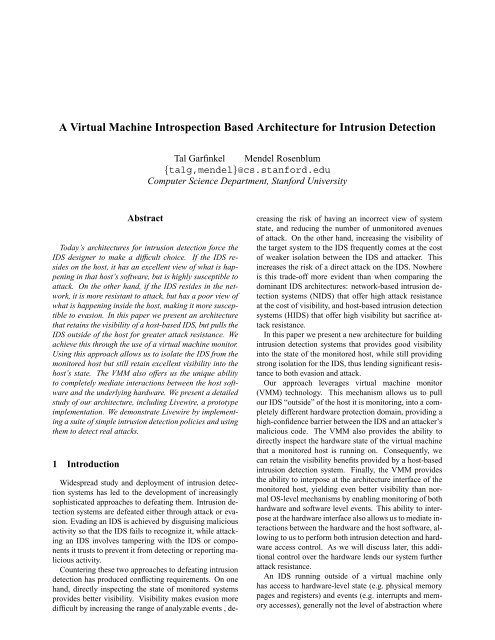
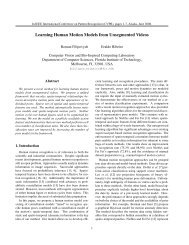
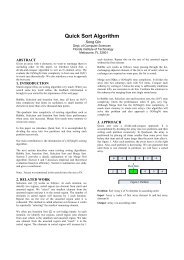
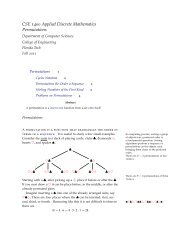
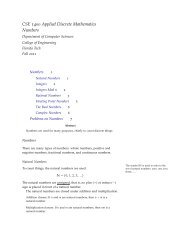
![{ public static void main (String[] args) { System.out.println (](https://img.yumpu.com/49719541/1/190x143/-public-static-void-main-string-args-systemoutprintln-hello-.jpg?quality=85)
